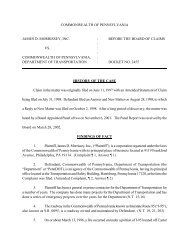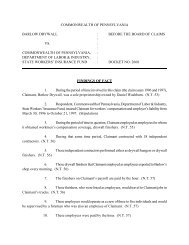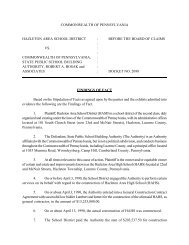3720 - Board of Claims
3720 - Board of Claims
3720 - Board of Claims
Create successful ePaper yourself
Turn your PDF publications into a flip-book with our unique Google optimized e-Paper software.
244. The Tilcon letter, Exhibit P-58, was admitted into evidence without objection<br />
from PennDOT. (N.T. 664).<br />
245. The parties do not dispute that the amount <strong>of</strong> asphalt used on the Project from<br />
August 2, 2002 to June 17, 2003, the delayed, actual completion date <strong>of</strong> the Project, was 28,989<br />
tons. (N.T. 806, 858-859; Ex. P-85 (12)).<br />
246. On August 8, 2002, Mr. Lizza notified PennDOT that Intercounty had incurred<br />
financial injury due to the construction delays including material escalations and that “asphalt<br />
prices are now increasing $4 a ton, when the work should have been long ago performed.” He<br />
requested additional payment for the asphalt under the Contract. (N.T. 602; Exs. P-44, P-58).<br />
247. In August 2002, PennDOT refused Intercounty’s request to pay for the material<br />
escalation cost <strong>of</strong> the asphalt. (N.T. 602-603).<br />
248. Mr. Lizza testified that after he received the Exhibit P-58 letter, he contacted<br />
Tilcon and reached a verbal agreement with Tilcon regarding payment. (N.T. 603-607).<br />
249. Mr. Lizza testified that, because Intercounty was experiencing losses in mid-2002<br />
due to the utility obstructions on the Project, Tilcon agreed it would supply the asphalt but would<br />
not invoice Intercounty for the material escalation at that time. They further agreed that<br />
Intercounty would pursue its legal remedies against PennDOT to recover its damages on the<br />
Project (including the subject amount for material escalation) and, when recovered, whether by<br />
judgment or settlement, Intercounty would then pay Tilcon the additional $4.00 per ton owed for<br />
the asphalt material. If there was any deficit between the amount recovered and the amount<br />
owed to Tilcon, that amount would remain a liability <strong>of</strong> Intercounty to Tilcon. (N.T. 603-607).<br />
250. At the hearing, the <strong>Board</strong> asked Mr. Lizza whether or not there was any written<br />
evidence <strong>of</strong> this oral agreement between Intercounty and Tilcon. (N.T. 652-653).<br />
251. At the next day’s hearing, Intercounty produced a Liquidating Agreement,<br />
marked as Exhibit P-86, that had been executed the previous evening by Tilcon and Intercounty.<br />
(N.T. 665-666; Ex. P-86).<br />
252. Mr. Lizza identified Exhibit P-86, explained that it was intended to document the<br />
original verbal agreement between Intercounty and Tilcon and testified that Exhibit P-86<br />
accurately reflected the terms <strong>of</strong> that agreement. (N.T. 665-666, 675-679).<br />
253. PennDOT objected to the admission <strong>of</strong> Exhibit P-86 into evidence on the grounds<br />
that the document did not previously exist, that PennDOT had not been told <strong>of</strong> the alleged verbal<br />
agreement between Tilcon until Mr. Lizza’s testimony the day before, that PennDOT had been<br />
told by Intercounty that the escalation amount had been paid, and that, as a result <strong>of</strong> the<br />
foregoing, PennDOT had been deprived <strong>of</strong> adequate discovery on this issue prior to the hearing.<br />
(N.T. 667-670, 673).<br />
33






